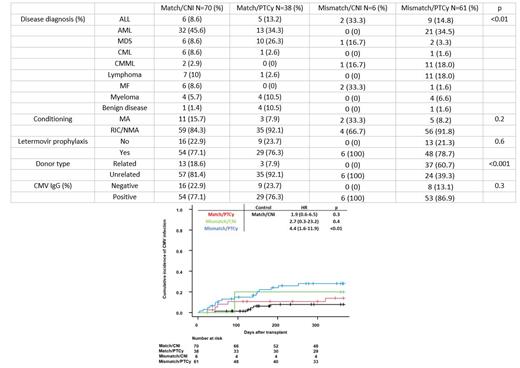Reports suggest that post-transplant cyclophosphamide (PTCy) for haploidentical and HLA-matched sibling donor allogeneic stem cell transplant (allo-SCT) is associated with a higher incidence of cytomegalovirus (CMV) infection than calcineurin inhibitor (CNI) for HLA-matched sibling donor allo-SCT. Prophylactic letermovir has been shown effective for CMV seropositive patients, based on the data mostly before the FDA approval of letermovir (2017). We reevaluated the risk of CMV infection in PTCy transplants.
We retrospectively analyzed 175 patients after allo-SCT between May 2019-May 2022). CMV infection was monitored at least for the first year by serostatus, viral load over 500 IU/mL, and/or evidence of CMV end-organ disease. Univariate and multivariate Cox regression analyses were used for the factors, including CMV serostatus, use of letermovir, GVHD prophylaxis, and HLA disparities, to affect the risk of CMV infection and graft-versus-host disease (GVHD)-free relapse-free survival (GRFS). Cumulative incidence curves were used to visualize the incidence of CMV infection stratified by HLA match and PTCY use. A landmark analysis at Day +100 was used for GRFS, where patients who had CMV infection beyond Day +100 (N=13) were assigned to the no-infection group.
Of the 175 patients, 108 received HLA-matched donors with GVHD prophylaxis, either CNI (N=70) or PTCy (N=38), while 67 received HLA mismatched donors with either CNI (n=6) or PTCy (N=66) ( Table). Letermovir was given to 137 patients (CMV IgG positive N=130, negative N=7) but not to 38 patients (CMV IgG positive N=12, negative N=26). CMV infection occurred in 28 patients (CMV IgG positive N= 28, CMV IgG negative N=0) before or after Day +100 (N=15 or N=13, respectively). CMV IgG positive recipients not receiving letermovir demonstrated a higher risk of infection by Day +100 than those receiving letermovir (Hazard ratio (HR) 10.1 (95% confidence interval (CI) 3.6-28.6), p<0.01). All 13 infections after Day +100 occurred after the cessation of letermovir (median: 82.9 days after cessation). On univariate analysis, PTCy and HLA mismatch donors increased the risk of CMV infection. The risk of infection by Day +100 increased with PTCy (p=0.07). The risk of infection after Day +100 increased with HLA mismatch donors (p=0.05). In addition, it was confirmed that HLA mismatch allo-SCT with PTCy increased the risk of CMV infection over matched allo-SCT with CNI ( Figure, HR 4.6 (95% CI 1.6-11.9), p<0.01), while HLA match allo-SCT with PTCy did not (p=0.3) (Figure 1). The trend was similar when analyzed only in the case of CMV infection by Day +100 (p<0.05) and after Day +100 (p=0.1). In the 130 CMV IgG seropositive patients who received letermovir, multivariate analysis showed that HLA mismatch donors with PTCy increased the risk of CMV infection over HLA match allo-SCT with CNI. When analyzed only for acute myeloid leukemia, acute lymphoblastic leukemia, and myelodysplastic syndrome with letermovir (N=91), HLA mismatch transplant with PTCy increased the risk of CMV infection over HLA match transplant with CNI (p=0.05), but not for HLA match transplant with PTCy. Landmark analysis demonstrated better GRFS in the PTCy group than the CNI group and in patients who received PTCy with CMV infection than those who received CNI without CMV infection (p<0.01).
PTCy increased the incidence of CMV infection in HLA mismatch allo-SCT by D+100 but not HLA match allo-SCT in the era of letermovir prophylaxis. Patients with PTCy transplant who overcome CMV infection have improved GRFS, possibly due to the increased graft-versus-leukemia effect. Further analysis is required to confirm the difference in the incidence of CMV infection between HLA match and mismatch transplant with PTCy and to assess the significance of late CMV (after Day +100) infection on GRFS.
Disclosures
Naik:Penn State Cancer Institute: Current Employment; Genentech, Inc., Abbvie: Research Funding; KPC Therapeutics: Honoraria.


This feature is available to Subscribers Only
Sign In or Create an Account Close Modal